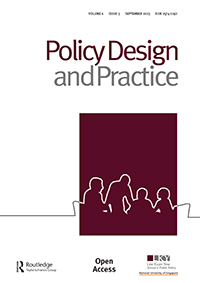参与政策设计的两种逻辑
IF 2.6
Q1 PUBLIC ADMINISTRATION
引用次数: 4
摘要
公民参与公共政策过程的形式化现在很普遍。尽管它很受欢迎,但如何设计这些举措,一方面创造合法的审议场所,另一方面解决实质性问题,仍然存在激烈的争论。本期参与性政策设计特刊通过对一系列旨在让利益相关者参与公共政策制定和决策的实践进行实证编目,为这些问题做出了贡献。这些案例涉及一系列国家和地方背景,为克服参与性政策设计举措的局限性和最大限度地发挥其潜力提供了一些见解。具体而言,它们有助于解开并更好地理解:参与设计的逻辑,这是那些关注利用包容性流程来改善结果的人的目标;以及参与设计的逻辑:这是那些寻求赋予参与者权力和民主合法性的人所倡导的。我们认为,这些不同逻辑的整合是促进变革性合作机制的关键。本文章由计算机程序翻译,如有差异,请以英文原文为准。
Two logics of participation in policy design
Abstract The formalization of citizen participation in public policy processes is now widespread. Despite its popularity, just how to design these initiatives to simultaneously create legitimate arenas for deliberation on the one hand, and substantive problem solving on the other hand, remains hotly contested. This Special Issue on Participatory Policy Design contributes to these questions by empirically cataloguing a range of practices aimed at engaging stakeholders in public policy creation and decisions making. The cases, which span a range of countries and local contexts, provide several insights for overcoming the limits, and maximizing the potential, of participatory policy design initiatives. Specifically, they help unpack, and better understand: the logic of participation for design which is targeted by those who are concerned with drawing on inclusionary processes to improve outcomes; and the logic of design for participation: which is championed by those who seek to empower the participants and democratic legitimacy. We argue the integration of these disparate logics hold the key for fostering transformative collaborative mechanisms.
求助全文
通过发布文献求助,成功后即可免费获取论文全文。
去求助
来源期刊

Policy Design and Practice
PUBLIC ADMINISTRATION-
CiteScore
10.30
自引率
4.30%
发文量
19
审稿时长
13 weeks
期刊介绍:
 求助内容:
求助内容: 应助结果提醒方式:
应助结果提醒方式:


